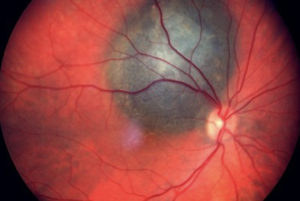Ocular Oncology
Ocular Melanoma
Ocular melanoma may consist of anterior segment, conjunctival or lid melanoma as well as melanoma of the uveal tract.The most common melanoma we see are iris and choroidal melanomas. Choroidal melanoma has the highest risk to the patient’s life, they may present with either blurred vision or flashes. Depending on the size of the choroidal melanoma determines whether we remove the eye (enucleation), apply local radiotherapy (brachytherapy) or use some form of local laser treatment such as photodynamic therapy (PDT) or transpupillary thermotherapy (TTT). The outcomes of treatment in terms of preservation of vision and the eye are generally very good.
In those patients who undergo removal of the eye (enucleation), the cosmetic outcome is generally excellent.When the eye is removed we generally replace the eye with a prosthesis (coral ball/acrylic ball) which means that the artificial eye when fitted is quite thin and allows for good conversational ‘movement’.
In summary, choroidal melanoma is an uncommon but serious tumour of the eye. If picked up early, the prognosis for maintaining the eye and for life is very good.
In relation to iris melanomas, these are less common and behave in a more benign fashion. They have much lower risk to the patient’s life in terms of metastatic disease to the liver. Many of our iris tumours we simply observe for growth at which stage we may need to remove the tumour from the iris or sometimes we apply radiation to the iris tumour. Conjunctival melanoma, though rare, is very serious in terms of its likelihood to spread via the lymphatics to the lymph nodes and other parts of the body. It generally requires aggressive surgical treatment as well as the use of topical cytotoxic drops.

